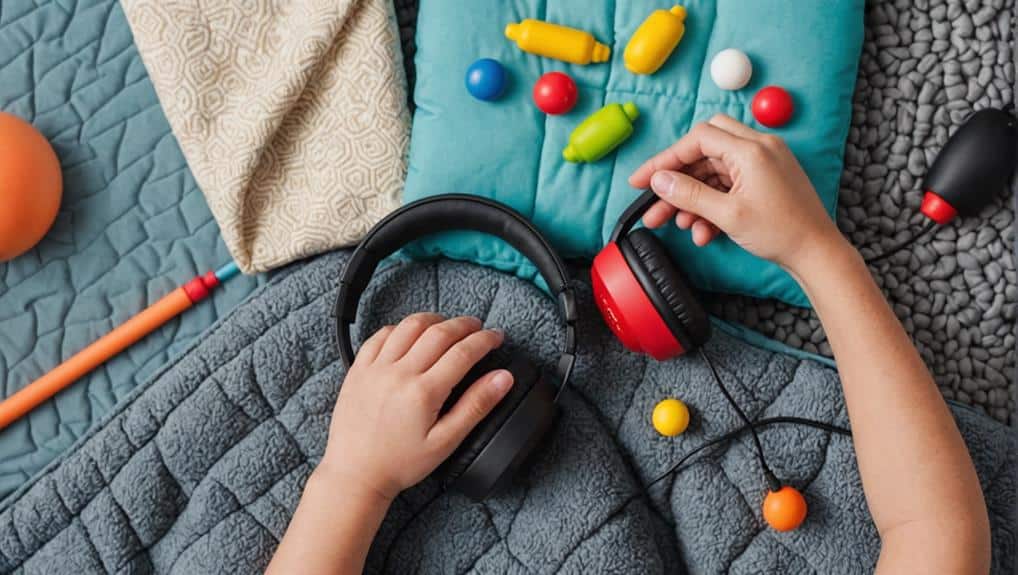Key Takeaways
- Sensory Processing Disorder (SPD) affects children’s responses to sensory information, impacting vision, hearing, touch, taste, and proprioception.
- Symptoms of SPD can manifest as hypersensitivity, hyposensitivity, or unusual behaviors, disrupting self-regulation, flexibility, and social interactions.
- Sensory processing issues often coincide with neurodevelopmental conditions like ADHD, affecting 5-16% of US and 8.3% of Finnish children.
- Occupational therapy therapeutic strategies and environment adjustments are vital in supporting children with SPD and helping them manage sensory challenges.
- Early identification and consistent assistance, lifestyle changes, and digital support are crucial for children with sensory processing issues to thrive.
Sensory Processing Issues: An Overview
Exploring the intricate world of sensory stimuli can be challenging for children with sensory processing issues. Sensory Processing Disorder (SPD) affects how children perceive and respond to sensory information like lights, sounds, smells, and textures. It’s crucial to note that SPD can affect all senses, including vision, hearing, touch, taste, and proprioception. Symptoms of SPD can manifest as hypersensitivity, hyposensitivity, or uncommon behaviors, and these varied behaviors may be mistaken for signs of ADHD.
Studies indicate that 5-16% of US and 8.3% of Finnish children experience these issues. These issues include distinct reactions to sensations, seeking or avoiding certain stimuli, and difficulties with fine motor skills—the impS.P.D. SPD on children’s growth and development can be significant, as senses play a crucial role in their skill development and performance. S.P.D..
SPD is often associated with neurodevelopmental conditions like Attention Deficit Hyperactivity DiA.D.H.D.er (ADHD) and Autism Spectrum DiA.D.H.D.er (ADHD). An occupational therapist aids children in managing these challenges through sensory Therapy. This Therapy helps children respond more effectively to sensory stimuli, improving self-regulation, flexibility, and social interactions—ParticulaTherapynificant in this Therapy is play-based activities.
Understanding SPD is essential for those who desire to serve others, particularly children. It equips them to support better these children’s distinct ways of understanding and interacting with the world around them. By improving sensory integration, we can help children with SPD navigate their environment more comfortably, enhancing their overall quality of life.
Impact on Children’s Lives
The ripple effects of sensory processing issues in children extend beyond mere responses to sensory stimuli. Children with sensory processing challenges struggle with self-regulation, flexibility, and social interactions. The impacts are seen daily, affecting everything from playing with friends to participating in school activities.
For instance, incorporating sensory breaks and calm spaces could help manage some of these challenges. Tailoring interventions to meet each child’s sensory needs is also vital, as each child’s experience with sensory processing issues is distinct.
Neurodevelopmental conditions, such as ADHD, often present sensory processing abnormalities. For these children, sensory challenges can intensify struggles with focus, emotional regulation, and social skills. They may respond unusually to sensory experiences, causing them to appear distracted, overwhelmed, or misunderstood.
The consequences of these sensory challenges on children’s lives are significant. They can prompt emotional upheaval, disrupt learning, and create obstacles to social interactions. This emphasizes the need for early identification and support so children with sensory processing issues can thrive in their environments.
Assessment and Support Strategies

Understanding and addressing sensory processing issues starts with thoroughly evaluating a child’s behavior. A Sensory Inventory can be a valuable tool for parents to measure their child’s sensory responses in different scenarios. This evaluation aids in pinpointing sensory challenges and assists in making well-informed choices about lifestyle adjustments and tailored sensory-based activities.
Educators can also contribute to creating a detailed sensory profile of the child. Their observations and evaluations in the educational setting can offer additional perspectives into the child’s sensory requirements and behaviors.
To support children with Sensory Processing Disorder (SPD), it’s crucial to understand their unique needs and offer tailored interventions. Occupational therapy, which provides strategies for sensory regulation, is often beneficial for these children.
| Evaluation | Assistance Strategies | Resources |
|---|---|---|
| Sensory Inventory | Sensory plans & activities | Occupational Therapy |
| Teacher’s assessments | Tailored strategies | Child psychologists |
| Parent’s assessments | Environment adjustments | Quirky Kid Clinic |
| Behavioral evaluations | Structured schedules | Educational resources |
| Consultations with experts | Consistent assistance | Community support groups |
Current Research and Data
These disorders can lead to over- or under-responsiveness to sensory stimuli, with signs including sensitivity to noise, touch, and textures. They can also result in emotional overwhelm, causing meltdowns or withdrawal.
Furthermore, these sensory processing issues can manifest in diverse ways, impacting motor skills, coordination, and speech. This is not just a mere inconvenience; it significantly affects children’s daily and environmental interactions.
Meta-analyses and inclusive studies provide invaluable data and insights into sensory processing disorders. These research efforts are instrumental in shaping our understanding of the disorder and guiding subsequent intervention strategies.
The data collected provides a clearer picture of the prevalence and implications of sensory processing issues in children. It catalyzes more focused research, driving us toward a deeper understanding of the disorder. This, in turn, will allow us to develop more effective support mechanisms, ensuring that children facing these challenges are given the best chance to overcome them and excel in their daily lives.
Available Resources for Support

Recognizing Sensory Processing Issues
Recognizing sensory processing issues in children is essential in addressing their unique needs and challenges. Sensory Processing Disorder (SPD affects how children perceive lights, sounds, smells, and textures. These sensory experiences can be overwhelming or underwhelming, leading to distinct reactions that are often the initial signs of sensory processing issues.
It’s crucial to watch for behaviors indicating your child has sensory processing issues. These might include uncommon responses to sensory stimuli, sensory seeking or avoiding behaviors, and difficulties with motor skills. Remember, approximately 5-16% of U.S. children and 8.3% of Finnish children experience these challenges.
| Signs | Possible Indications | Response |
|---|---|---|
| Unique Reactions | Child may be overwhelmed by lights, sounds, smells, or textures | Seek professional advice |
| Sensory Seeking or Avoiding | The child may seek or avoid specific sensory experiences | Observe and understand their preferences |
| Difficulties with Motor Skills | The child may struggle with tasks requiring fine or gross motor skills | Provide supportive therapies |
| Associated Conditions | The child may have ADHD, ASD, or other neurodevelopmental conditions. | Seek multidisciplinary support |
| Daily Life Challenges | The child may struggle with routine tasks | Create a supportive, understanding environment |
Behavioral Challenges and Responses

Exploring the maze of behavioral challenges presented by children with sensory processing disorders can be a demanding task. These children may exhibit extreme behaviors such as screaming when their face gets wet or throwing tantrums due to sudden environmental changes. It is essential to understand that these are not willful acts of defiance but responses to sensory overload. These responses can be mitigated by engaging them in sensory integration exercises, like balance board challenges or proprioceptive pushing activities, which can help them better regulate their sensory input.
Sensory overload can lead children to flee from or become aggressive in specific environments. The key to managing such behaviors lies in understanding the child’s sensory needs and creating an environment that caters to these needs. Some children may be drawn to water, finding it calming. Others may seek out stimulating environments to satisfy their sensory cravings.
Creating calming or stimulating environments based on the child’s needs can help mitigate these behavioral challenges. The goal is to provide a safe space where the child can navigate their sensory experiences without feeling overwhelmed. By doing so, we can help children with sensory processing disorders interact with their environment more healthily, reducing the incidence of extreme behaviors and increasing their comfort and happiness.
Understanding Sensory Processing
After thoroughly discussing the behavioral challenges, it’s beneficial to shift our focus toward the underlying mechanism that causes such responses—sensory processing. This intricate process involves the brain receiving, interpreting, and responding to sensory information from our environment and bodies. It encompasses the five primary and internal senses, such as p and proprioception, contributing to our body awareness.
A child with sensory processing issues may struggle with seemingly simple tasks. They may have an exceptional pain tolerance, difficulty with movement, or distorted spatial awareness. They may react adversely to certain stimuli, leading to behavioral challenges that are often misunderstood. Understanding these triggers is vital to supporting these children effectively.
Occupational therapists are vital professionals in this field. They can assess the child’s sensory processing abilities and create tailored interventions. These interventions aim to improve the child’s ability to process sensory information effectively, enhancing their fundamental function and participation in daily activities. Understanding sensory processing can build a compassionate and practical approach to supporting children with these issues.
Misinterpreted Behavior and Its Impact

While it is easy to label children with sensory processing issues as ‘picky’ or ‘sensitive,’ this often leads to a severe misunderstanding and misinterpretation of their behaviors. Misinterpreted behavior in these children can result from over-stimulation due to sensory challenges. This sensory overload can trigger spontaneous or extreme behaviors, causing significant distress for the child and caregivers.
The mental well-being of children facing these challenges is severely affected. They may exhibit anxiety, irritability, anger, or fear, impacting their social interactions and overall quality of life. Poor body awareness, another consequence of sensory processing disorders, can lead to clumsiness and difficulties with coordination and movement.
Moreover, sensory distractions can contribute to developmental delays in children. This highlights the importance of early identification and support to mitigate these impacts. Understanding the root of these behaviors and equipping ourselves with the proper knowledge and tools can facilitate better support for these children. In doing so, we can help them thrive despite their sensory challenges and provide them the understanding and care they need.
Frequently Asked Questions
What are Processing Disorders in Children?
Processing Disorders in Children refer to difficulties in how the brain interprets sensory information, like touch, sound, or movement. These challenges can affect a child’s ability to engage in everyday activities and social situations.
How Do I Know if My Child Has Sensory Processing Issues?
Identifying sensory processing issues in children involves observing distinctive reactions to sensations, sensory seeking or avoidance behaviors, and motor skills difficulties. Utilize a Sensory Checklist for assessment and consider professional consultation for accurate diagnosis.
How to Help a Child With Sensory Processing Issues?
Implement sensory diets and individualized activities to assist a child with sensory processing issues. Utilize resources like the Quirky Kid Clinic and sensory checklists. Collaboration among parents, teachers, and psychologists is vital for tailored support.
What Are the Four Types of Sensory Processing Disorder?
The four types of Sensory Processing Disorders are sensory modulation disorder, sensory-based motor disorder, sensory discrimination disorder, and sensory-based feeding disorder. Each affects a child’s response and interaction with sensory stimuli differently.
Can a Child With SPD Live a Normal Life?
Yes, a child with Sensory Processing Disorder can lead a fulfilling life. With early identification, targeted interventions, and supportive environments, these children can effectively manage sensory challenges and participate in routine activities.


Recent Comments